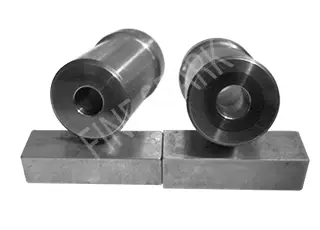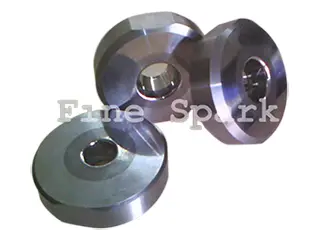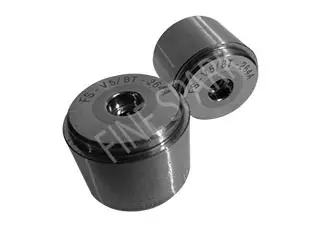Products Info
(DIES for ARMS & AMMUNITION i.e. Bullet Dies & Casing Dies, Cutting & Cupping Dies , Extrusion Dies, Wire Drawing Dies, Tube & Bar Drawing Dies, Cold Heading Dies & Forging Dies, Power Pressing Dies, Fastener Dies, Nib Dies, Draw Dies, Pen Industries Dies, Round Dies, TC RINGS for Sleeves, Forming/Formation Dies & Punch(BLANKS), All Wear Parts, etc…) TUNGSTEN CARBIDE BUSHES: (T.C.BUSH, Drill Jig Bushes, Guide Bushes, Special Bushes, All Wear Parts, etc.) CARBIDE SPECIAL PUNCHES: (Profile Punch, Pressing Punch) GAUGES: (Carbide Gauges, Steel Gauges, Checking Gauges, Ring & Snap Gauges) TUNGSTEN CARBIDE CUTTING TOOLS. JOB WORK: (EDM-Sparking on Steel & Carbide, OD & ID Grinding, Wire Cut, Lapping & Polishing of CARBIDE ID, FACE & FORM)

1.) BLANKING DIES
(CUTTING AND CUPPING DIES)
2.) FORMING DIES
(BULLET PROFILE, BALL PEN PROFILE)
3.) DRAW DIES
(TOP DRAW DIE, MIDDLE DRAW DIE, BOTTOM DRAW DIE)(1ST DRAW DIES, 2ND DRAW DIES, 3RD DRAW DIES, FINAL DRAW DIES)
4.) HEADING DIES
(HEADING DIE)
A blanking die produces a flat piece of material by cutting the desired shape in one operation. The finish part is referred to as a blank. Generally a blanking die may only cut the outside contour of a part, often used for parts with no internal features. Three benefits to die blanking are: Accuracy, Appearance & Flatness

1.) CHAMBER
2.) NOZZLE
3.) SLEEVE
4.) BUSH
1.) BLANKING & CUPPING PUNCH
The drawing operation is very similar to the forming operation except that the drawing operation undergoes severe plastic deformation and the material of the part extends around the sides. While Forming dies bend the blank along a curved surface.It uses the punch and the die to create the desired form.
A metal cup with a detailed feature at the bottom is an example of the difference between formed and drawn. The bottom of the cup was formed while the sides were drawn.

2.) FORMING PUNCH
Extruding is the act of severely deforming blanks of metal called slugs into finished parts such as an aluminum I-beam. Extrusion dies use extremely high pressure from the punch to squeeze the metal out into the desired form. The difference between cold forming and extrusion is extruded parts do not take shape of the punch.

Range of Products
| Sr. No. | Name of Stores / Products / Items | Specification | Qualitative Capacity | Qua. Capacity Per month |
|---|---|---|---|---|
| 1. | BLANKING DIES (CUTTING
& CUPPING DIES) DRAWING DIES (TOP, BOTTOM & FINAL DRAW DIES) FORMING DIES (PROFILE LIKE BULLET, POINITNG etc.) EXTRUSION DIES SWAGING DIES (NECKING) HEADING & TRIMMING DIES |
MOC:- TUNGSTEN CARBIDE, STEEL & ALLOY STEEL | ACCURACY AND PRECISION LIKE CONCENTRICITY, RUN OUT, PARALLISM,
PERPENDICULARITY from 0.002mm up to 0.010 mm Maximum DIAMETER UPTO 250mm |
1000 Nos. |
| 2. | BUSH (GUIDE BUSH) NOZZLE (FOR SAND BLASTING) SLEEVE |
MOC:- TUNGSTEN CARBIDE, STEEL & ALLOY STEEL | ACCURACY AND PRECISION LIKE CONCENTRICITY, RUN OUT, PARALLISM,
PERPENDICULARITY from 0.005 mm up to 0.010 mm |
1000 Nos. |
| 3. | PUNCH FOR DIES | MOC:- TUNGSTEN CARBIDE, STEEL & ALLOY STEEL | ACCURACY AND PRECISION LIKE CONCENTRICITY, RUN OUT, PARALLISM, PERPENDICULARITY from 0.002mm up to 0.010 mm | 1000 Nos. |
Information About Materials We Use
- CARBIDE:
Tungsten Carbide (WC) is one of the most successful composite engineering materials ever produced. Its unique combination of strength, hardness and toughness satisfies the most demanding applications. These characteristics are effectively unrivaled by any other material , which makes it the work-horse as a tool for metal cutting, metal forming , structural components, wear parts and other applications requiring severe abrasion resistance. Wear resistance is the most outstanding feature of tungsten carbide. If the material also has to withstand deformation, impact, heavy load, high pressure, corrosion and high temperature, tungsten carbide is often the only material that can fulfill these requirements satisfactorily. In the years the demand of Tungsten carbide has tremendously increased.
- STEEL:
- Carbon Steels:
Carbon steels contain trace amounts of alloying elements and account for 90% of total steel production. Carbon steels can be further categorized into three groups depending on their carbon content: Low Carbon Steels/Mild Steels contain up to 0.3% carbon Medium Carbon Steels contain 0.3 – 0.6% carbon High Carbon Steels contain more than 0.6% carbon
- Alloy Steels:
Alloy steels contain alloying elements (e.g. manganese, silicon, nickel, titanium, copper, chromium and aluminum) in varying proportions in order to manipulate the steel's properties, such as its hardenability, corrosion resistance, strength, formability, weldability or ductility. Applications for alloys steel include pipelines, auto parts, transformers, power generators and electric motors.
- Carbon Steels:
- TUNGSTEN COPPER:
This alloy is a pseudo-alloy of copper and tungsten. As copper and tungsten are not mutually soluble, the material is composed of distinct particles of one metal dispersed in a matrix of the other one. The microstructure is therefore rather a metal matrix composite instead of a true alloy. The material combines the properties of both metals, resulting in a material that is heat-resistant, ablation-resistant, highly thermally and electrically conductive, and easy to machine.
